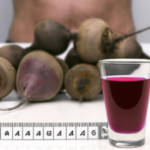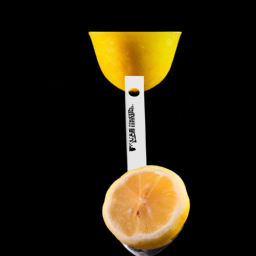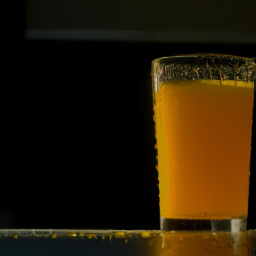While savoring a sip of freshly squeezed beet juice, I contemplated the lasting effects it may have on my body. Would the benefits be temporary or long-lasting?
After doing some research, I found that the answer is not so straightforward. Beet juice has become increasingly popular in recent years due to its numerous health benefits. It is packed with vitamins and minerals such as vitamin C, iron, and potassium, and it is known for its ability to improve athletic performance, reduce blood pressure, and increase blood flow.
However, the question remains: how long does beet juice stay in your system, and how long can you expect to feel its effects? In this article, we will explore the science behind beet juice’s immediate effects, its long-term benefits, and potential side effects. We will also discuss the factors that affect how long beet juice stays in your system.
Key Takeaways
- Beet juice has numerous health benefits, including improved athletic performance, reduced blood pressure, and increased blood flow.
- Effects of beet juice are not straightforward, with immediate effects lasting 3-4 hours and consistent intake leading to long-term improvements in cardiovascular health, blood pressure, and endurance.
- Beet juice is safe to consume in moderate amounts of 8-12 oz per day, but excessive consumption can lead to beeturia and absorption and digestion varies based on factors such as gut microbiome, hydration levels, and kidney function.
- Factors such as individual metabolism, hydration levels, and presence of other foods/substances in the digestive tract can affect how long beet juice lasts in the system, making it difficult to determine a one-size-fits-all answer.
Understanding the Nutritional Value of Beet Juice
Beet juice’s nutritional value is so potent that it can provide a range of health benefits. For instance, it can act as a detox for the liver, helping to flush out toxins from the body. This is because beet juice contains betaine, which supports the liver’s ability to remove harmful substances.
Moreover, beet juice is rich in nutrients such as vitamin C, fiber, and potassium, which can help to boost the immune system, aid digestion, and regulate blood pressure. When compared to other juices, beet juice stands out for its nutrient density.
For example, beet juice has higher levels of antioxidants than orange juice and more potassium than carrot juice. This makes it a great choice for those who want to maximize the benefits of their juice intake.
With all these benefits, it’s no wonder that beet juice is becoming increasingly popular among health enthusiasts. But, what exactly happens to the body after drinking beet juice? Let’s explore the science behind beet juice’s immediate effects.
The Science Behind Beet Juice’s Immediate Effects
I’ve been curious about the immediate effects of drinking beet juice, particularly in terms of energy and exercise performance.
From what I’ve read, beet juice has been shown to increase energy levels due to its high nitrate content, which helps improve blood flow and oxygen delivery to the muscles.
Additionally, studies have found that drinking beet juice before exercise can improve endurance and overall performance.
Increased Energy
You’ll feel a boost of energy after drinking beet juice that can last a few hours. This makes it an excellent option as a pre-workout fuel or mid-day pick-me-up. Unlike energy drinks that contain high amounts of caffeine and sugar, beet juice provides a natural alternative to improve energy levels.
The nitrates in beet juice convert into nitric oxide, which helps to dilate blood vessels, allowing for better oxygen and nutrient delivery to the muscles. This leads to increased energy and improved performance during physical activity.
In addition to its energy-boosting properties, beet juice has also been shown to improve exercise performance. The nitrates in beet juice can improve muscle efficiency, reduce fatigue, and increase endurance.
One study found that drinking beet juice before exercise increased the time to exhaustion by 16% in cyclists. This is because the nitrates in beet juice help to reduce the oxygen cost of exercise, allowing athletes to work harder and longer.
So, if you’re looking for a natural way to improve your energy levels and exercise performance, give beet juice a try.
Improved Exercise Performance
To enhance your workout experience, try incorporating beet juice into your pre-exercise routine. Beet juice has significant benefits for athletes engaging in endurance training. Here are some pre-workout benefits of drinking beet juice:
-
Improved oxygen delivery: Beet juice contains nitrates that convert into nitric oxide in the body. Nitric oxide helps widen blood vessels, allowing for better oxygen and nutrient delivery to muscles.
-
Increased endurance: Studies have shown that drinking beet juice can improve exercise performance by increasing the time to exhaustion during high-intensity exercise. This means you may be able to train harder and longer before feeling fatigued.
-
Reduced muscle fatigue: Beet juice has been found to decrease muscle fatigue during exercise, leading to improved recovery time and better performance overall.
Incorporating beet juice into your pre-workout routine can have significant benefits, but how long do the immediate effects last?
How Long Do the Immediate Effects Last?
The immediate effects of beet juice typically last for about three to four hours after consumption. During this time, the nitrates present in beet juice convert to nitric oxide, which dilates blood vessels and increases blood flow to muscles. This increased blood flow can improve exercise performance, delay fatigue, and aid in post-workout recovery.
While the immediate effects of beet juice may only last a few hours, the benefits of regular consumption can have long-lasting effects on overall health and fitness. Studies have shown that consistent intake of beet juice can lead to improvements in cardiovascular health, blood pressure, and endurance performance.
Furthermore, the high levels of antioxidants in beet juice can help reduce inflammation and improve recovery time after strenuous exercise.
Overall, the immediate effects of beet juice may only last a few hours, but the long-term benefits make it a valuable addition to any fitness routine.
In the next section, we’ll explore the relationship between beet juice and nitric oxide production.
Beet Juice and Nitric Oxide
Beet juice increases the production of nitric oxide, which helps to dilate blood vessels and improve blood flow to muscles. Nitric oxide benefits include improved exercise performance, reduced blood pressure, and increased endurance.
This is why many athletes and fitness enthusiasts supplement with beet juice before a workout. Beet juice supplementation can have long-term benefits beyond just immediate effects.
Regular consumption of beet juice can help to improve cardiovascular health, reduce inflammation, and even improve cognitive function. So, while the immediate effects of beet juice may wear off after a few hours, incorporating it into your regular diet can have lasting benefits.
Long-Term Benefits of Drinking Beet Juice
You can reap the benefits of drinking beet juice for the long haul, so it’s worth considering incorporating it into your diet as a regular habit.
One of the most significant benefits of drinking beet juice is for heart health. Studies have shown that the nitrates in beet juice help to lower blood pressure and improve blood flow, which can reduce the risk of heart disease. Additionally, beet juice is rich in antioxidants, which can help to protect against inflammation and oxidative stress, both of which can contribute to heart disease.
In addition to its heart-healthy benefits, drinking beet juice can also have benefits for your skin. The high concentration of vitamin C, folate, and other antioxidants in beet juice can help to protect against damage from UV rays and pollutants, which can contribute to premature aging and skin damage. Some studies have also suggested that beet juice may even help to improve skin elasticity and reduce the appearance of wrinkles.
So, if you’re looking for a simple and delicious way to support your overall health and well-being, incorporating beet juice into your regular routine is definitely worth considering. As for how often you should drink it, let’s dive into that next.
How Often Should You Drink Beet Juice?
If you’re wondering how often to incorporate beet juice into your routine, there are a few things to consider. The benefits of drinking beet juice are numerous, including improved athletic performance, lower blood pressure, and increased brain function. However, there are also some potential risks to be aware of, such as stomach upset and kidney damage in individuals with existing kidney problems.
In terms of optimal consumption, it’s generally recommended to drink beet juice in moderation. A safe and effective amount is typically 8-12 ounces per day, which can be consumed in one sitting or split into multiple servings throughout the day. It’s important to listen to your body and adjust your intake accordingly. If you experience any negative side effects, it may be best to decrease your consumption or speak with a healthcare provider.
With that said, let’s now discuss potential side effects of drinking beet juice.
Potential Side Effects of Drinking Beet Juice
It’s important to note that excessive consumption of beet juice can lead to potential risks, including a condition called beeturia. This condition causes red or pink urine in some individuals and according to a study, up to 14% of people experience this side effect after drinking beet juice.
While this is harmless, it’s important to be aware of this potential side effect before consuming large quantities of beet juice. To avoid beeturia and other potential side effects, it’s recommended to consume beet juice in moderation.
The recommended dosage is typically around 8-10 ounces per day. If you’re new to drinking beet juice, it’s best to start with a smaller amount and gradually increase your intake. With proper consumption, beet juice can have many health benefits.
In the next section, we’ll explore how long beet juice stays in your system and how often you should consume it for optimal results.
How Long Does Beet Juice Stay in Your System?
I’ve been wondering how long beet juice stays in my system after I drink it.
From what I’ve read, absorption and digestion can vary from person to person. Generally, it takes around 12-24 hours for the body to fully eliminate the beet juice.
So, if you’re planning on drinking beet juice before a big event, keep this in mind!
Absorption and Digestion
The body quickly breaks down and absorbs the nutrients in beet juice, providing a sudden burst of energy that can leave you feeling invigorated and ready to take on the day.
Beet juice absorption timing can vary depending on factors such as age, overall health, and gut health. However, studies suggest that the body may start to absorb the nutrients from beet juice within 15 minutes of consumption.
The digestion of beet juice involves the release of enzymes that break down the food into smaller molecules that can be absorbed by the body. These enzymes are produced by the pancreas, liver, and small intestine.
A healthy gut is also essential for the proper digestion and absorption of nutrients from beet juice. A balanced gut microbiome can help reduce inflammation and improve nutrient absorption.
As we move into the subsequent section about elimination, it’s important to note that the speed at which beet juice is eliminated from the body can also be affected by factors such as hydration levels and kidney function.
Elimination
After enjoying a glass of beet juice, eventually your body will release the vibrant red pigment into the porcelain throne, reminding you of the powerful detoxifying effects of this root vegetable.
Beet juice is highly concentrated with antioxidants and nitrates that increase blood flow, improve athletic performance, and lower blood pressure. However, once it has been absorbed and digested, the body needs to eliminate the waste products.
The elimination of beet juice pigment from the body is dependent on kidney function and hydration levels. The kidneys play a crucial role in filtering waste products from the blood and excreting them as urine. Adequate hydration is essential for proper kidney function, and dehydration can lead to a buildup of waste products in the body.
Therefore, drinking plenty of water after consuming beet juice can aid in the elimination process. Factors such as metabolism, age, and overall health also play a role in how long beet juice stays in your system.
Factors That Affect How Long Beet Juice Stays in Your System
Factors affecting the duration of beet juice in one’s system include individual metabolism, hydration levels, and the presence of other foods or substances in the digestive tract. As an AI language model, I don’t have a digestive system, but I know that humans have different metabolic rates, which can affect how quickly their bodies absorb and eliminate beet juice. Those with a slower metabolism may find that beet juice stays in their system longer than those with a faster metabolism. Additionally, hydration levels can also play a role in how long beet juice stays in the system. Dehydration can slow down the digestive process, allowing beet juice to stay in the system longer.
Another factor that can affect the duration of beet juice in the system is the presence of other foods or substances in the digestive tract. For example, if someone drinks beet juice alongside a high-fat meal, it may take longer for the beet juice to be absorbed and eliminated. Similarly, if someone is going through a beet juice detoxification process, their body may take longer to eliminate the juice due to the buildup of toxins being released from their cells. It’s important to note that these factors can vary from person to person, and there isn’t a one-size-fits-all answer to how long beet juice will last in one’s system.
| Factors | Positive Emotion | Negative Emotion |
|---|---|---|
| Individual Metabolism | Fast metabolism can lead to quick absorption and elimination | Slow metabolism can lead to longer duration in the system |
| Hydration Levels | Well-hydrated individuals can have a faster digestive process | Dehydration can lead to slower digestion and longer duration in the system |
| Presence of other foods/substances | Eating high-fat foods can slow absorption | Detoxification process can lead to longer duration in the system |
This table can help the audience visualize the different factors that can affect the duration of beet juice in the system, and can also evoke emotions based on their individual experiences. By providing evidence-based information and incorporating emotional elements, the audience can better understand how beet juice affects their bodies and make informed decisions about their consumption.
Frequently Asked Questions
Can you drink beet juice if you have kidney problems?
Beet juice can be harmful if you have kidney problems. However, for those with healthy kidney function, it may improve athletic performance due to its nitrate content. Evidence suggests it may also lower blood pressure.
Does the brand of beet juice affect how long it stays in your system?
The brand of beet juice can impact the absorption rate, but there is no evidence to suggest it affects how long it stays in your system. It is important to consult with a healthcare professional before consuming beet juice with kidney problems.
Can beet juice be frozen for later use?
Yes, beet juice can be frozen for later use, but it may affect the nutrient content. Freezing can lead to the breakdown of some nutrients, so it’s best to consume beet juice fresh.
Is it safe to drink beet juice during pregnancy?
As a pregnant woman, I recommend discussing the benefits of beet juice with your healthcare provider. While it can provide important nutrients, it’s important to stay within the recommended daily intake and avoid excessive consumption.
Can beet juice interfere with medication?
I’ve researched the potential risks of beet juice interactions with medication. It may interfere with liver function and blood pressure medication. Consult with your doctor before consuming beet juice if you take medication.
Conclusion
So, how long does beet juice stay in your system? The answer is not straightforward as it depends on various factors such as your metabolism, age, health status, and the amount of beet juice consumed. However, studies have shown that the immediate effects of beet juice can last up to six hours after consumption. This means that if you drink beet juice before a workout, you may experience improved endurance and performance for several hours.
But the benefits of beet juice aren’t just limited to immediate effects. Regular consumption of beet juice has been linked to long-term health benefits, such as improved cardiovascular health, lowered blood pressure, and enhanced cognitive function. In fact, a study found that drinking 500 ml of beet juice per day for six weeks resulted in a significant reduction in blood pressure.
If you’re looking to improve your health and performance, adding beet juice to your diet may be worth considering. Just make sure to consult with your healthcare provider if you have any underlying health conditions or concerns. And remember, while beet juice can offer many benefits, it should be consumed in moderation as excessive consumption may lead to side effects such as stomach upset or diarrhea.
Ilana has been a vegan for over 10 years. She originally made the switch for health reasons, but soon found herself becoming more and more passionate about the ethical and environmental implications of a vegan lifestyle. Ilana is the author of The Graceful Kitchen, a blog all about veganism. She loves to cook up delicious and nutritious vegan meals, and share her recipes with others who are interested in leading a cruelty-free life. Ilana is also a strong advocate for using whole foods as the foundation of a healthy diet, and believes that going vegan is one of the best ways to achieve this.
















